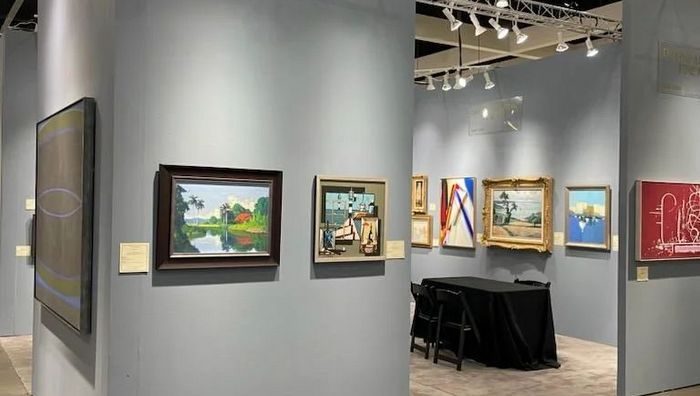For Matilde Perez (Chile, 1920), you get there in art only if you know how to “get” there in life. Ninety years of life and active career speak volumes of the veracity and conviction of her statement. But it’s not just an artistic statement; it was and still is an ethic attitude and an existential will.
For Matilde, being an artist is a must, with no more justifications than the desire to grab a paintbrush and start painting. Only armed with this assertion and being a mature woman with a respected career in her country, he left for Paris in 1960 to unravel Europe’s new pictorial trends. She left all experiences behind and traded her concrete artistic horizon for a new visual approach that was more dynamic and ludicrous, yet far riskier: kinetic art.
Though legitimized and expanded throughout Europe, while acclaimed in Latin America in Venezuela and Argentina, kinetic art as a coherent movement never bloomed in Chile. In the 1960s, Chile’s art was swaying between formalism –staunchly defended by the Signos group made up of Jose Balmes, Gracia Barrios, Alberto Perez and Bonati– and the abstract-concrete trend represented by the Rectangulo group, with Ramon Vergara Grez at the helm. Matilde, who was a member of the latter group, had broken away from it because, in her view, the movement had come to a formal and conceptual standstill.
Her stay in Paris, her relationship with Vasarely, Le Parc and the Groupe de Recherche D’Art Visuel (GRAV) encouraged her to pepper her works with the latest kinetic art breakthroughs of that time and create optical illusions with textures and relieves. Matilde had discovered a new and right-on-track way for her work that she was not ready to give up on. Upon returning from Paris in 1962 with all those new proposals in tow, she had to cope with the rejection and incomprehension of Chile’s intelligentsia toward kinetic art. She was mockingly referred to as a blister-making artist and several conservative headlines even read: “those infernal machines and signals…”1
Though critics either ignored her or turned her down, she continued working under the new movement’s criteria. In 1970 she returned to Paris and managed to wrap up her studies on kinetic art. It was at that moment when she introduced real motion and light in her artworks that gave them a more objectifying and dynamic character that also included the spectator’s hands-on involvement.
Back in Chile in 1975, she mustered up the support of some of her colleagues from the School of Design at the University of Chile –where she taught– and founded the Center for Kinetic Research, a sort of free workshop that lasted little more than a year. Once again, Matilde’s intentions to make kinetic art a part of the national poetics were thwarted.
Approximately for four decades she remained that way, nearly buried in oblivion, just creating for herself. Her work endured some kind of self-enclosure, a condition that was clearly shown by the fact that most of her pieces –the most valuable ones, by the way– are hanging on the walls of her house in Santiago de Chile. Even though Matilde’s artworks sell for lump sums of money in auctions and out in the market, and museums and public collections begin now to realize the historic gap of not having a “Matilde”, she refuses to let go of those “children” that were shrugged off for so long.
Thus, Matilde came to Havana with her works virtually under her arms. The Latin American Gallery of Casa de las Americas became her temporary “living room” for the Cuban public to take a look at her pieces for the first time ever and, above all, to get to know her. Since 1984, Matilde Perez’s works had not been exposed personally outside the Chilean boundaries, not even in such a far-reaching exhibit.2
Kinetics, the title of the exposition in Casa, let us peek at an artist who’s been consistent with a peculiar way of living that she eventually splayed in her works. She held on tight to kinetic art despite the lack of support just because she thought it was the best and most efficient way to break away from the nation’s traditional painting trend and put a new spin on it based on a multidirectional and moving visual approach. Matilde wields no theories or mathematic rules, just a natural sensitivity for pure forms and color, let alone an acute logic of the plane and perception as her working tool of choice.
Kinetics shows off an evolution, not only in the artist’s career, but also in the making process of her artworks. The calculation of a sketch, a primary drawing and then the end object to wrap it all up, round out the cycle of life of a piece that can be looked into right here without missing out on details. Matilde doesn’t care whether we reveal her secret. She comes out unbiased to show the whole process she’s just followed through. “Go ahead, copy it,” she seems to tell us. At the end of the day, that’s what this is all about: kinetic art is an experience you need to feel, and the more we’re compromised, the better.
Sticking to this process, the artist decided to leave a piece in Cuba to engross the artistic assets of the Casa de las Americas collection, but on one condition. “I give you the sketch and you carry it through.” She made us all creators in one way or another and, like in that experience of hers back in 1975 with the kinetic art workshop, she started making a huge canvas out of a 1971 sketch that was eventually executed by a bunch of art students from Havana’s San Alejandro Academy.
The untitled work sketch –like most of her pieces– stands for one of the motifs Matilde has pegged away at the most: the optical-geometrical relationship among the rhombus, the square and the circle. Slight displacements of the figures that almost miss the eye conform a spatiality too hard to come by, either in a small 30-inch serigraphy or in a huge 9-foot-long canvas. Her mastery of field depth, her ability to pick the right color, among other ingredients, are superb. The rest is left for the spectator to assess.
And the latter is precisely the one that paradoxically is to bear the brunt of the exposition: learning it. Ramon Castillo, the exhibit’s curator and one of the researchers who has delved deeper into Matilde’s work, once called her efforts “the art of patience” and he is darn right. If you’re in a hurry, you miss the essence of the works. That’s a hard requirement for the contemporary public with little time, for a public that goes by and looks without seeing, that intends and believes to have captured the sense of an artwork by just standing for a few minutes in front of it. Understanding Matilde takes people to wait for the piece to communicate with them. You ought to wait and hope to be lucky, wait for the piece to work on you, to click just when you ask it to. Her works live to the artist’s very tempo. And just like her, they suffer from aches of their own and shuffle along, but they do touch the right chord every time.
Then comes the sentence: do you like it or not? But that’s something Matilde Perez doesn’t give a whit for. If she made you stop and stare for as long as it takes, her goal has been met because at the end of the road, she demands no more time from you. She has no interest in praises or recognitions.
Once the exposition has been dismantled, her artworks –formerly blasted by the critics and now showered with praises– will go back on the walls of her place, their natural location, to be enjoyed in a personal fashion, just as she prefers.





Previous publication Elusive PARAGUAY
Next publication Cildo Meireles. Against hegemonic ideas in art
Related Publications

How Harumi Yamaguchi invented the modern woman in Japan
March 16, 2022
Giovanni Duarte and an orchestra capable of everything
August 26, 2020







